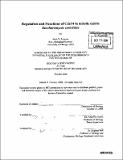| dc.contributor.advisor | Angelika Amon. | en_US |
| dc.contributor.author | Tomson, Brett N | en_US |
| dc.contributor.other | Massachusetts Institute of Technology. Dept. of Biology. | en_US |
| dc.date.accessioned | 2009-08-26T17:13:25Z | |
| dc.date.available | 2009-08-26T17:13:25Z | |
| dc.date.copyright | 2008 | en_US |
| dc.date.issued | 2009 | en_US |
| dc.identifier.uri | http://hdl.handle.net/1721.1/46654 | |
| dc.description | Thesis (Ph. D.)--Massachusetts Institute of Technology, Dept. of Biology, 2009. | en_US |
| dc.description | Includes bibliographical references. | en_US |
| dc.description.abstract | In order to ensure the accurate formation of two daughter cells from one parental cell, the series of events that comprise the mitotic cell division cycle must be carefully regulated. Much of this regulation affects the transitions between the stages of the cell cycle, which are controlled by proteins known as cyclin dependent kinases (CDKs). High levels of CDKs promote mitotic entry, whereas the inactivation of CDKs drives exit from mitosis and entry into the next cell cycle at the G stage. In the budding yeast Saccharomyces cerevisiae, the evolutionarily conserved phosphatase Cdcl4 regulates many events in anaphase, including the inactivation of CDKs. The activity of Cdcl4 is thought to be restricted to anaphase due to two signaling networks, the Cdc fourteen early anaphase release (FEAR) network and the mitotic exit network (MEN). Although the major components of these two pathways have been identified, their regulation is not fully understood. Here we examine how the members of the FEAR network function together to regulate Cdc 14 and its targets in anaphase. One function of Cdc 14 in early anaphase is to promote proper segregation of ribosomal DNA (rDNA). We have determined that Cdcl4 is required to resolve a novel type of linkage between chromosomes, which occurs at the rDNA locus due to transcription-dependent processes. We also characterize the regulation of Cdc 14 activity by the FEAR network component Spo 12. Specifically, we found that Spo 2 must be phosphorylated in a conserved domain during anaphase in order for Cdc 14 to function in early anaphase. Spol2 phosphorylation is dependent on the CDK, Cdc28, whereas Cdcl4 contributes to the dephosphorylation of Spol2. Lastly, we show that Spol2 phosphorylation is regulated by the FEAR network components Espl and Slk19, but not by the MEN. Overall, this thesis describes research that establishes a new model for both the regulation and significance of the FEAR network in controlling Cdc 14 during anaphase in Saccharomyces cerevisiae. | en_US |
| dc.description.statementofresponsibility | by Brett N. Tomson. | en_US |
| dc.format.extent | 178 leaves | en_US |
| dc.language.iso | eng | en_US |
| dc.publisher | Massachusetts Institute of Technology | en_US |
| dc.rights | M.I.T. theses are protected by
copyright. They may be viewed from this source for any purpose, but
reproduction or distribution in any format is prohibited without written
permission. See provided URL for inquiries about permission. | en_US |
| dc.rights.uri | http://dspace.mit.edu/handle/1721.1/7582 | en_US |
| dc.subject | Biology. | en_US |
| dc.title | Regulation and functions of Cdc14 in mitotic exit in Saccharomyces cerevisiae | en_US |
| dc.type | Thesis | en_US |
| dc.description.degree | Ph.D. | en_US |
| dc.contributor.department | Massachusetts Institute of Technology. Department of Biology | |
| dc.identifier.oclc | 426982609 | en_US |
